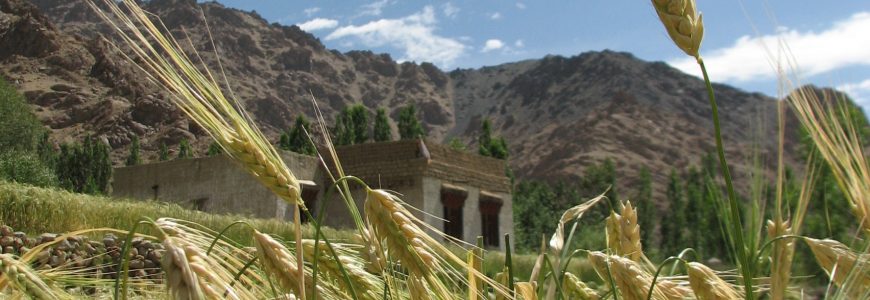In 2009 I embarked on what would be an amazing adventure. I’d set out for international travel before, but there was something symbolic about this journey, as if the location was pulling me in, that there was something I would find there beyond cultural exchange and photographic experiences. I was told by a healer friend that she saw this trip for me as a sunrise, golden rays encompassing the entirety of the sky. I held on to this image as the airplane headed east, stretching halfway around the world to India.
This four month trip indeed seemed to open my future up like a seed, germinated by the glowing sun. I was introduced to truths, many deeply beautiful and many tragically hard. This trip was indeed the sunrise to my future in farming, seed saving, community integration, dedication to sustainability, and stewardship.
This journey led me high up into the Himalayas, to arid Ladakh, with its high elevation and towering white peaks that felt protective, rather then forbidding. It reminded me of home, the steep of Mt. Shasta. While in Ladakh, I participated in a program run by the International Society for Ecology and Culture (ISEC). The program’s goal is to pair individuals with Ladakhi families and to create a multifaceted exchange that addressed development, globalization, cultural traditions, sustainability and subsistence agriculture. Before the road was built in the 70’s, linking the villages of Ladakh with greater India, Ladakhi culture rested on the foundation of the community. As the global world drove in, and currency glowed richer than a field of dried barley, the youth left, the men left and communal foundation started to be chipped away into private islands of individual identity. A people, become many entities vying to wear never-before-delineated badges of economic status, material goods, formal education, and autonomy. Through my experience living there, the juxtaposition was glaring. Among many of these contrasts, was me, a westerner traveling halfway around the world to learn from Ladakhi culture what ”traditional” living is like, to find that the younger generation had left home to earn money for their parents who are only ”poor farmers”. My heart felt some kind of healing with time spent in these ”poor villages”, where work was done communally, where your day was expressed in cycles that felt intuitive: milk the cow, make butter, put butter on your morning bread and in your (what would be one of many) cup of tea, hand wash laundry, pray, pull weeds in the barley and collect to feed to the cow in the morning when you milk her, help a neighbor with apricot harvest (along with everyone else in the village, as they’ll travel to every household to help with harvest), and so the days went. I was welcomed to be a part of the pattern, to be in the braid of a cut field of golden barley, in the weave of a woolen tunic, the living story of butter as it melts in tiny cups of black tea. This strong earthen house of community was my sunrise into a humble and different way of living, one that felt authentic. It was the journey into something deep within me, passed on from many grandmothers.
The seed that was given fertile elements to grow in India has been planted at Homeward Bounty Farm. There are times however, when I feel the sunrise, but in its corse it does not always send out as many embracing rays. To be a single farmer on this land can at times feel cold, a woolen jacket made purely of single strands, where the wind finds its way in. It at times feels very unintuitive to be doing a job that ancestrally belonged to everyone. It’s ironic in many ways, this ”American” way of running a farm, doing it all by ones self, an individual seeking out their dreams and succeeding through hard work. But agriculture is the work of many!
And so I sowed the seed from India with the knowledge that from one seed will come many! I sowed the seed in hopes that it would grow a village. My folks have become farmers by my side and my neighborhood friends a community that works together. This amazing community is creating a farm that is theirs, it’s coming together to grow and harvest more than just food crops, but a fundamental structure of our common abundance together and recognition of our bounty.
The inspiration to travel back to my memories of Ladakh came this weekend while harvesting onions. Together, CSA members, family and friends rose early and came into the field to work. Soon everyone was at ease, indeed tapping into our grandmothers, pulling onions, trimming up their tops and roots and placing them into boxes, our village putting-up food for the winter. We sat in the field, talked about fishing, weddings, sisters and daughters. We made jokes and laughed and enjoyed a more lively beverage than tea, beer. The field of onions changed from representing hours of work and was replaced the an intuitive act of gathering around food for communal benefit, much like in the barley fields of Ladakh. The transition of wealth at that moment shifted from ”what we’re worth hourly,” into baskets of colorful onions that have a communal story of hands and hearts that will provide encompassing nourishment.
The sun continues to rise, the rays stretch out and this farm grows, for our village and because of our village. Thank you to everyone who’s embraced and become of a part of this journey.






























































